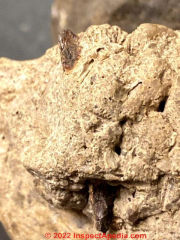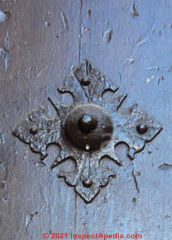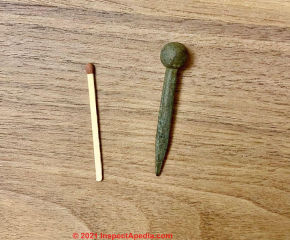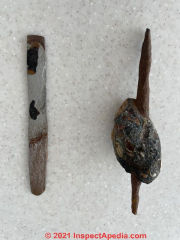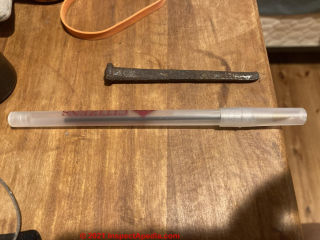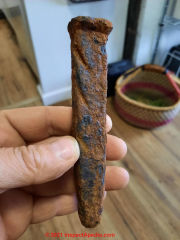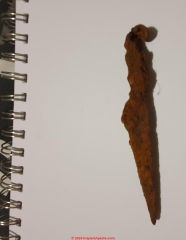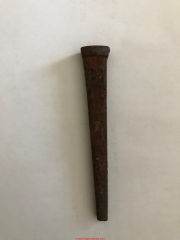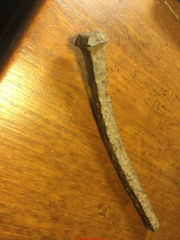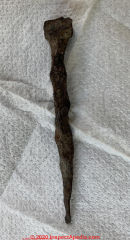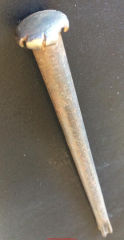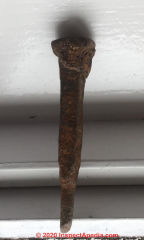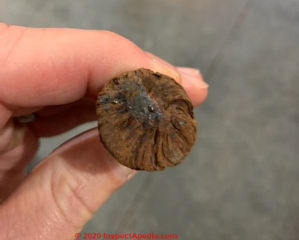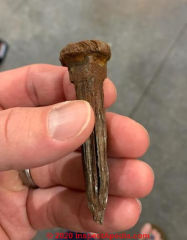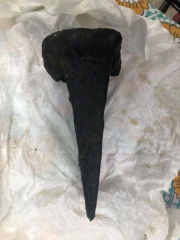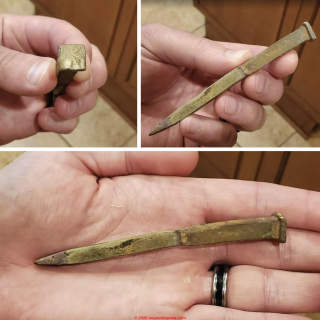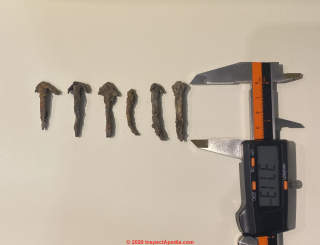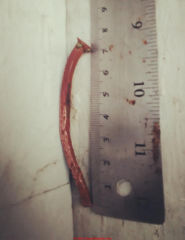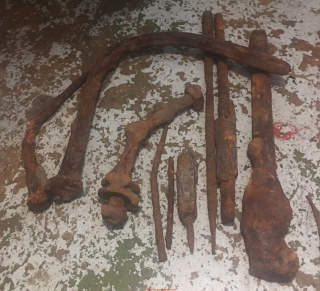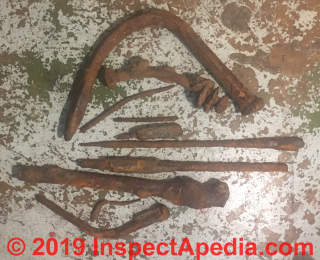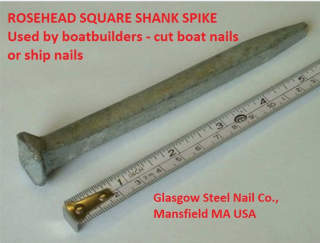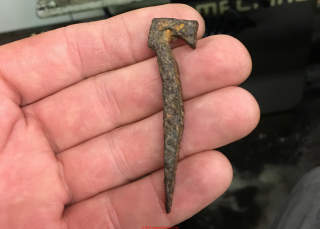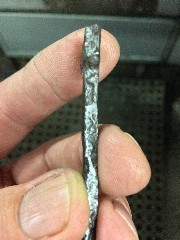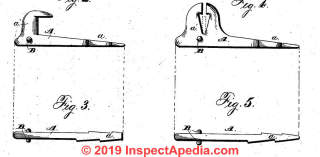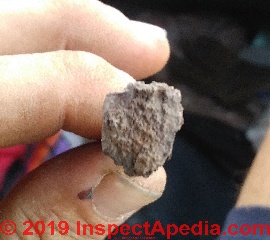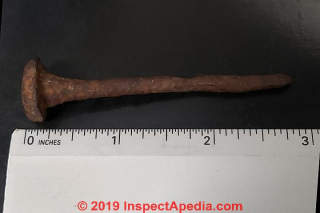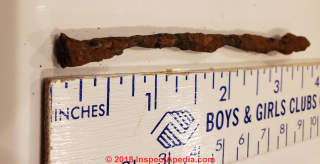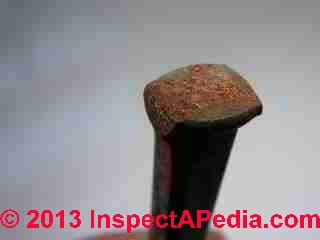 Nail Age & History FAQs
Nail Age & History FAQs
Nails as Indicators of Building Age
- POST a QUESTION or COMMENT about determining building age by examining its hardware
Antique & Modern Nail age and history questions & answers.
This article series describes antique and modern cut nails focusing on hand wrought and cut nails used in wood frame construction or interior finishing or carpentry work.
Companion articles in this series describes and illustrates antique & modern hardware: door knobs, latches, hinges, window latches, hardware, nails & screws can help determine a building's age by noting how those parts were fabricated: by hand, by machine, by later generations of machine.
InspectAPedia tolerates no conflicts of interest. We have no relationship with advertisers, products, or services discussed at this website.
FAQs on Finding the Age of Nails
These questions & answers about determining the age of nails and other building hardware were posted originally at the topic home page:
NAILS, AGE & HISTORY - home - be sure to review that article.
Also see the nail age determination questions and answers suggested
at NAIL AGE DETERMINATION KEY - use this key to guess at the age of your nail or spike
Reader Comments, Questions & Answers About The Article Above
Below you will find questions and answers previously posted on this page at its page bottom reader comment box.
Reader Q&A - also see RECOMMENDED ARTICLES & FAQs
[Click to enlarge any image]
On 2021-11-01 by CanalKid
Found in very old stone wall ? Any ideas? Located in Massachusetts
On 2021-10-29 by inspectapedia.com.moderator
@Steve Campbell-Wright,
The round upper shank of your nail makes it a modern fastener.
Be sure to see the nail ID and age tips given at
NAIL AGE DETERMINATION KEY - use this key to guess at the age of your nail or spike
On 2021-10-29 by Steve Campbell-Wright
I am hoping to identify this nail. It is 3 inches long with a head dia of 9/16". The upper part of the shank is round, and the lower part is forged to a rectangle with a chisel point. There is a 'W' forged into the countersunk head.
What is its purpose, and how old is it please?
On 2021-10-20 by inspectapedia.com.moderator - When did the moulded (molded?) nails become popular ?
@Jason M Gould,
I'm not sure what you mean by molded nails, but if you mean round wire nails, their history is included in the page above.
On 2021-10-20 by Jason M Gould
@danjoefriedman, thank you!
When did the moulded (molded?) nails become popular then?
On 2021-10-19 by (mod) - early machine-cut nails made by 1790
@Jason M Gould,
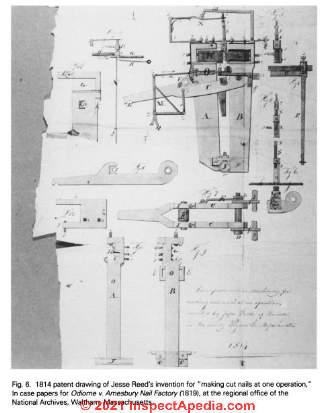 It certainly has merit. Nails were cut from forged blanks, even by hand-operated machines at least from the early 1800s and possibly as early as 1790. (How, 2018 & How, 2009 ) (Phillips, 1993).
It certainly has merit. Nails were cut from forged blanks, even by hand-operated machines at least from the early 1800s and possibly as early as 1790. (How, 2018 & How, 2009 ) (Phillips, 1993).
Cut nails were valuable, and in addition to being made by small hand operated machines would have been imported from England, from France, and perhaps also made further West in the U.S. or shipped to that coast.
@Jason M Gould,
Continuing, Phillips notes that
By 1788, Adam Rogers, of Marshfield, had developed a machine that "cut nails from hoops or plates," and by 1792 his nephew, Samuel Rogers, was cutting nails "by hand in a small machine invented by him.
When cut from nail plate, the nails produced by the hand-operated machines would probably have had characteristics similar to those of nails manufactured a few years later, but with less refinement.
The earliest cut nails would have had shanks with two tapering and two parallel sides and burrs on diagonally opposite edges (having been cut from the same side of the nail plate), like their later cousins.
However, because of the crude, somewhat uncalibrated method of cutting, the shanks in cross-section would probably have appeared as skewed rectangles or parallelograms, rather than true rectangles (Fig. 2).
The nails would have had rounded ends (from the edge of the nail plate) and were probably initially hand-headed, sometimes with faceted rose or "T" heads found on wrought nails, other times the upper end simply bent over to produce a brad.
Eventually, crude heading machines may have been used.
Below, courtesy of Phillips (1993) is an illustration of the 1814 Reed Cut Nail Machine patent, found in the patent infringement lawsuit papers in Oiome v. Amesbury Nail Factory (1819) at the regional office of the National Archives, Waltham MA.
On 2021-10-19 by Jason M Gould - could cut nails have appeared in Duncan Creek at gold rush sluice boxes?
My grandfather and his siblings and parents were part of the Klondike gold rush, 1898-1904. He wrote in a newspaper, decades later, about his father's mining group, “While on the prospecting trip the party went into the Duncan Creek area which later became the fabulously wealthy Keno Hill and Mayo country. Here they found sluice boxes nailed with nails that had been cut rather than moulded.
This indicated prospectors had been in that area in the early ‘70’s and ‘80’s – long before the Klondike strike in 1896."
Do you have any idea if this statement has merit? And do you know what types of nails would have been used during the 1896-1899 timeframe in Yukon Territory, vs. earlier than that?
Thank you!
On 2021-10-15 by inspectapedia.com.moderator (mod) - shipwreck nails found in the Philippines
@Christian Manalo,
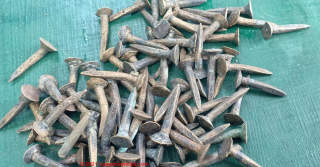 To get a general idea of the composition of those tacks or small nails
To get a general idea of the composition of those tacks or small nails
1. use a magnet - to see if they're iron or steel vs. perhaps brass or another non-magnetic metal
2. scrape the surface to see if you observe shiny brass or copper
From just the photo they look like galvanized iron
On 2021-10-15 by Christian Manalo
@inspectapedia.com.moderator,
Can you identify what metal been used on these nails. My brother found these on unknown wooden shipwreck buried in the sand along the shore in the Philippines.
On 2021-10-13 by inspectapedia.com.moderator (mod)
@Hugh Dickman,
in the live links above please check out
NAIL AGE DETERMINATION KEY - use this key to guess at the age of your nail or spike
On 2021-10-13 by Hugh Dickman
Hey was wondering if you can age these nails
On 2021-09-13 by inspectapedia.com.moderator (mod)
@Sue,
What I can see in the photo is a four-sided iron fastener, not necessarily a nail, and as you say it's embedded in a piece of iron strapping, it could have been a bolt. I can't offer a more-useful comment;
But at
NAIL AGE DETERMINATION KEY - use this key to guess at the age of your nail or spike
https://inspectapedia.com/interiors/Determine-age-of-old-nails.php
you will see that we provide a list of questions that you can try to answer that give what I call contextual information about your metal find that can help guess at its use and history.
On 2021-09-13 by Sue
I found this piece of iron with nail in. Is it possible to date/name this type of nail please. Found near harbour in Scotland/UK
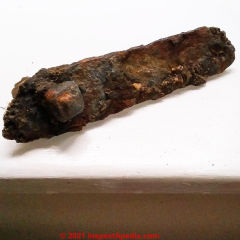
On 2021-08-30 by mak.church (mod) - bronze nail found in a garden in The Hague in the The Netherlands
Very nice; looks like brass or copper; am I right?
A bulbous headed tack / nail of matchstick size might have been used where its head was left exposed to view, such as a decorative nail in a door or other building feature; smaller gauge tacks with decorative heads also show up on upholstered furniture.
Any information about the history of the specific site in the Hague might give us more clues.
To go WAY back you might enjoy seeing
Butler, J.J., BRONZE AGE METAL and AMBER in the NETHERLANDS [PDF] University of Groningen Library, Netherlands, retrieved 2021/08/30 original source: https://ugp.rug.nl/Palaeohistoria/article/download/24902/22350
@Andrew Wills, here's an excerpt from a photo of a wooden door with metal decorations that might include bronze bulb-headed short nails.
In addition to all the information about old nails on this page, I encourage you to see the information and examples at the following articles:
Antique Nail Age & History FAQs Q&A on Nails as Indicators of ...
inspectapedia.com/interiors/Age-of-Nails-FAQs.php
and
Age and History of Antique Nails
https://inspectapedia.com/interiors/Determine-age-of-old-nails.php
On 2021-08-30 by Andrew Wills - nail found in garden, the Hague in the The Netherlands
Hi - I found the nail shown in the attached image in a friend's garden in The Hague in the The Netherlands. Any information about its history would be much appreciated.
Many thanks
On 2021-07-29 by inspectapedia.com.moderator (mod)
@Leslie Weyhrich,
Show us a photo of raisin head nails and tell us what you can about the product - that may help locate the box you want.
On 2021-07-29 by Leslie Weyhrich
looking for an original box of raisin head nails don't need the nails just the box!
On 2021-07-10 by mak.church (mod)
@Beck,
Thank you for the interesting photos and for your question. We can’t see enough nor do we have any other contextual information to say more than there appear to be a couple iron fragments. With respect to age, there are some clues in the article above. Also see:
Age and History of Antique Nails
https://inspectapedia.com/interiors/Determine-age-of-old-nails.php
On 2021-07-09 by Beck
I found these recently on 2 separate beach walks. They look handmade but I'm not sure what I have here. Any ideas?
On 2021-07-06 by mak.church (mod)
@Whitney Tomlin,
In addition to all the information about old nails on this page, take a look at the following page and its easy questions to help determine nail age:
Age and History of Antique Nails
https://inspectapedia.com/interiors/Determine-age-of-old-nails.php
You may also enjoy examples from other readers' 'finds' at:
Antique Nail Age & History FAQs
inspectapedia.com/interiors/Age-of-Nails-FAQs.php
On 2021-07-06 by Whitney Tomlin
Hi! Wondering if you all might be able to help me determine the age of an old farmhouse I’m currently working on. I have managed to pull one of the original nails out without damaging the nail too much. Please take a look at the image and let me know if you have any idea. Thanks!
On 2021-07-03 by inspectapedia.com.moderator (mod)
@Anonymous,
Sure, in the article above take a look at the description of cut nails.
On 2021-07-02 by Anonymous
We are doing a roof to a house that got finished in 1905 the rumor is the house started being built in 1901 there has been only 2 people to own the place...we found a few of these nails it looks like the same style nails in the picture that says they are vintage can someone help me to see what kinda nails these are?
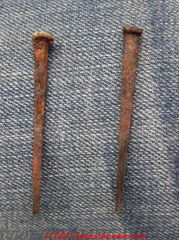
On 2021-07-03 by inspectapedia.com.moderator (mod)
@Keith,
That is certainly a remarkable Spike. I don't know what it was for. Possibly Timber framing.
Sometimes people cut grooves in the spikes to improve their resistance to withdrawal but more-likely their regularity suggests that those are grip marks left by machinery used in nail or spike production.
On 2021-07-02 by Keith
I found this metal detecting on an old rural Nova Scotia property. Any idea how old it is? What are the grooves for? Measures 3/4" square and about 5 3/4" long
On 2020-12-07 - by (mod) - Square capped stud-nails: in France?
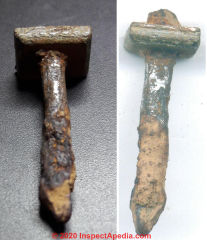 Yvres
Yvres
Meci beaucoup pour
le photo avec un ongle intéressant.
Je vais regarder autour de moi pour voir ce que je peux trouver d'autre, mais à première vue, il semble que cela puisse avoir été un goujon décoratif comme on en trouve parfois sur la surface de portes ou de coffres maintenant antiques.
It looks as if it may have been a decorative nail such as found in "studded" doors.
On 2020-12-07 by Yves
Hello, I am French and I am looking for answers concerning this object in my possession.
Rivet, or nail, The rectangular plate is in bronze measures 10mm X 8mm thickness 3mm (similar to a spangle)
crossed by an iron point with a length of 23mm and diameter 3mm.
the tip is worked like a nail. this one crossing the bronze plate.
The edges of the insert are chamfered.
On 2020-11-25 by Anonymous
@Anonymous,
Easily
On 2020-11-25 by Anonymous
@McKenna,
Provide evidence it was from the Mississippi or BONNE TERRE railroad
On 2020-11-25 by McKenna
After reviewing this article along with credible documentation. I have a 1839 copper nail.
Still have the railroad lumber as well. To date this is the oldest found. Irregular shape, clearly no "modernized" tools used, and diameter/length precise. Beyond valuable and will provided 4 pictures only if that person truly knows how much it's worth as I do.
On 2020-11-15 - by (mod) -
Mark
We need to start with a decision on what sized nails you need. The plate thickness determines the dimensions of the nail shank.
If you're not sure, just pick up a nail whose design you like. There is no one "right size" nail stock plate.
Consider that the nail length and width and taper vary, and the nail type and size range is huge, from tiny brads to structural fasteners.
Just as example data points,
a No. 8 common nail has a diameter of about 4.115 mm wire.
On 2020-11-10 by MarkE
I would like to make bronze cut nails. What thickness bronze plate should I cut them from?
On 2020-11-06 - by (mod) -
RE-Posting: Kyle said:
We found this with a metal detector about 8” deep on a dirt road through the woods of Southborough, Ma.
We believe it is some sort of nail from the early 1600s. What do you think? It’s about 5” long and 3/4 inch thick with a tapered end like a chisel
Advertisement deleted.
On 2020-11-02 - by (mod) - Daytona Beach nail rusted very thin
 Vladimir
Vladimir
Let's try the Nail age determination key at
https://inspectapedia.com/interiors/Determine-age-of-old-nails.php
On 2020-11-02 by Vladimir
Found this nail in Daytona Beach, trying to find out how old this nail might be. [Photo above]
On 2020-10-10 - by (mod) -
Amy:
Often there are many additional house age one can find, even in a renovated home, by careful inspection; layout, architecture, site debris, and the several topics suggested in
the ARTICLE INDEX such as saw marks on original framing lumber that you may see in the attic, basement or crawl space.
On 2020-10-10 by Amy
I'll have to investigate further! Most of the house has been renovated extensively so the attic and anything we can figure out inside of it is our only hope! Thank you!
On 2020-10-09 - by (mod) -
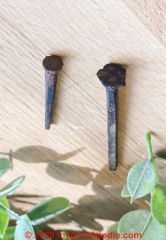 Yes that larger-headed nail looks hand-wrought. The two nails look of different age to me.
Yes that larger-headed nail looks hand-wrought. The two nails look of different age to me.
Remember to note just where and how the nail was used; for example if we see what appear to be original nails in original framing of a building we can figure they're probably as old as the structure while if we're seeing add-on structure or materials obviously we can't assume that.
Take a look at the other building age clues in this article series - when deciding the age of a building it is important to use all of the available evidence and to correlate it; saw kerfs or marks, hammer marks, timber surfaces, other building hardware, architectural style : there is plenty to consider.
Rebuilding an 1850s home in Wappingers Falls NY I was thrilled to find, on tearing up a damaged floor below a toilet, old newspapers that pretty much told me the date at which plumbing - at least the toilet - had been added to the home.
The plumber stuffed newspapers all around the toilet bend - maybe hoping that if his work leaked it would not be discovered until after he'd safely escaped.
On 2020-10-09 by Amy
Thank you for the resources! I guess I just thought this would help to figure out what time frames we were looking at for construction here. From what I can tell, the nail head and from the nail head to the shank is irregular, but the shank towards the very bottom is more uniform. Here's another picture of it and another one that we found up there as well.
On 2020-10-09 - by (mod) -
Amy
Take a look at NAIL AGE DETERMINATION KEY at https://inspectapedia.com/interiors/Determine-age-of-old-nails.php
and look for some of those features on your nail, for example: in your photo I note that the nail taper is not uniform, but has a widening area under the head; up close you may be able to see burrs on one or more of the four edges, and you may be able to see that the head was machine stamped (making it modern);
Of course a nail alone isn't the age of a home, as nails come into a building at various times and uses, so where it's found and fastening what to what are important.
Also we have an entire series of articles on how to determine the age of a house, starting at AGE of a BUILDING, HOW to DETERMINE https://inspectapedia.com/Design/Age_of_Building.php
Please take a look and don't hesitate to ask follow-up questions.
On 2020-10-09 by Amy
Hi there! We bought an old house and we can't seem to find out when it was built. We found square nails in the attic and wondered if it would help us figure out about when the home was built. What do you think?
On 2020-10-08 - by (mod) -
Brenda I don't see the nail at all. But if you are referring to a wooden peg used to join wood furniture parts, those have been used for hundreds if not more than a thousand years and are still used in the present by some craftsmen. A few years ago I built a reproduction of a Shaker end table that was assembled using glue and wooden pegs, with no metal fasteners.
On 2020-10-08 by Brenda
Is this an older nail or modern?
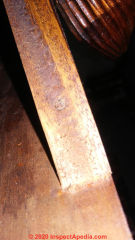
On 2020-10-08 - by (mod) -
Joel
That looks like a round-shafted nail - making it modern - but I can't say for sure from your photo
On 2020-10-08 by Joel Williams
On 2020-08-25 - by (mod) -
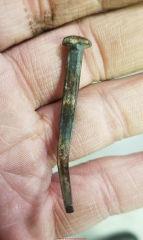 That looks pretty modern to me, Clint; cut nail with side ridges and center bulge is very similar to Tremont's current series.
That looks pretty modern to me, Clint; cut nail with side ridges and center bulge is very similar to Tremont's current series. Is it bronze?
On 2020-08-25 by Clint Walker
I live in the Yukon Territory, Canada (Klondike Gold Rush) an have found some pieces of an old boat.
Hand hewn keel / bow.
This [photo above] is what the nails look like. Vintage?
On 2020-08-19 - by (mod) -
Connor, that's a reasonable guess, given similar fasteners we've seen. This one looks a bit largeOn 2020-08-19 by Connor Flynn
Hi really having difficulty identifying and ageing this item
, i suspect its a wire fence fastener but i am not certain.
On 2020-08-19 4 - by (mod) -
RalphTake a look at my comments about cut nails that taper uniformly from head to tip, in this article: NAIL AGE DETERMINATION KEY https://inspectapedia.com/interiors/Determine-age-of-old-nails.php
as I think that will be helpful
On 2020-08-19 by Ralph
I don't know if my first post came through.
I found this nail in the backyard of the building where my daughter lives in Chicago (Now divided into apartments). I wondered if it was a replication or some old. Can you help?
Ralph
I found this nail in the backyard of the old house (now apartments) in Chicago. It made me wonder if it was reproduction or something old. There has been some work done on the house and around it. Can you help?
On 2020-08-11 by Heidi Schjoth
Lake superior northern michigan beach detecting find many of these and very long bent iron pins.
On 2020-08-12 by Jonathan
looks to me like it will be 1839 to present.
On 2020-08-10 - by (mod) -
Age guess for an antique Queensland AU cut nail with tapered faceted head.That looks like a hand forged uniform-taper cut nail. Take a look at the age estimate guide at NAIL AGE DETERMINATION KEY, Jonathan, and let me know what you find.
https://inspectapedia.com/interiors/Determine-age-of-old-nails.php
On 2020-08-09 by Jonathan
Can anyone advise me about this nail? It’s approx 6 inches, square and was found near Maleny, Qld, Australia
On 2020-07-26 - by (mod) -
MartinBest bet is to start by taking a look at NAIL AGE DETERMINATION KEY https://inspectapedia.com/interiors/Determine-age-of-old-nails.php
On 2020-07-26 2 by Martin
If I were to send a photo of a nail I found, could someone give me an opinion?
On 2020-07-20 - by (mod) -
NathanCan you attach a photo?
On 2020-07-20 by Nathan
6 inch nails in the uk 1955 ish, can you tell me what they where made of? As they seemed to snap easier than newer nails ? Thanks you
On 2020-07-19 by (mod)
Chris, That's a fluted tip ironspike, machine made.
Fluted tip spikes or nails are often used to nail into concrete. They may be used to attach structural members or often, insulation. An example is produced by OMG Roofing Products.
See this FLUTED NAIL DESCRIPTION [PDF] from OMG
On 2020-07-19 by chrisb8154
Hello
My name is Chris, can you help me find out what this object is called and what it does? I have had no luck after many hours of research. Hope you can help thanks!
On 2020-07-06 - by (mod) - Round-ish 4-sided hand-wrought nail age, Suffolk England
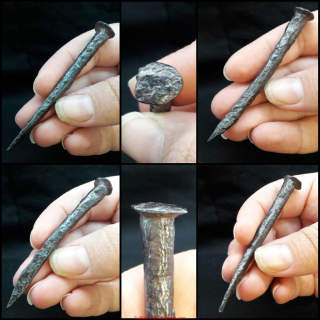 Sarah:
Sarah:
Re: age of hand-wrought round headed nail in the UK
[Click to enlarge any image]
That looks like a hand-wrought nail to me, though it won't be as old as 1066, more likely the early 1800's. I'm basing that guess on
- the round-ish but not uniformly-round tapered shank - if the shank is actually flat-sided then it's an early cut nail, probably with a hand-wrought head
- the off-center point or tip
- the rather thin and irregular rounded head on the nail
- what appear to be remains of hammer marks along the shank
Thanks for the photos and question, Sarah.
"Machine-made" bears some discussion and clarification; even in the 1700s people were using hand or foot-operated levers or "machines" to cut nails from heated iron blanks, then hand-forging the nail head by inserting the nail into an opening in an anvil or similar device.
That's an operation that was distinct from fully-mechanized steam, water, or later electric-powered nail cutting machines and of course all of those continued in production overlapping "modern" round wire-based nails that are more-easily distinguished.
In this article series we discuss iron fibre direction (across vs along the nail shank), and head design, and tapering of nail shank, and cut marks on nail edges as further age-clues.
On 2020-07-06 by Sarah
I am trying to find out how old this nail may be and if it is machine or hand made.
It is about 80mm long and the head is about 11mm wide and although round, not a perfect circle. It does go to a point rather than a blunt tip. It's very rectangular all the way down. It does feel a bit more round directly under the head, but also looks like 4 distinct sides, so I'm not sure if the roundness is due to actually being round or due to corrosion.
I've clean it the best I could in the photos. I found this yesterday while digging a garden in my yard. Location is Suffolk England more specifically Mildenhall. Even more specifically... near an old mill that was recorded as being around since 1066.
Most info on the mill I could easily find including pictures was during the 1800s(Parker's mill)
Any help with an approximate date and if it's hand made or machine made would be awesome! Every thing I have been reading has just confused me more.
On 2020-07-05 by Anonymous
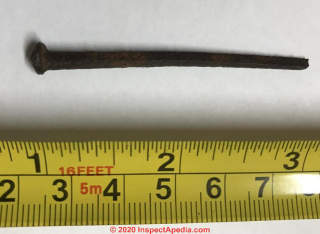 Thanks for your reply Dan, probably not the best photo.
Thanks for your reply Dan, probably not the best photo.
Cheers
Annie
On 2020-07-04 - by (mod) - age of cut nail, Western Australia
Annie
I see a cut nail shank that seems to taper uniformly - clues
at NAIL AGE DETERMINATION KEY be helpful.
That rose head may indicate that the nail is old enough that the head was hand-forged after the blank was cut.
On 2020-07-04 by Anne
Hi I found this [photo above] whilst prospecting Western Australia. Square nail, rose head. Any idea of an age?
Thank you
Cheers
Annie
On 2020-07-03 - by (mod) - cut nails in an 1810 English style barn
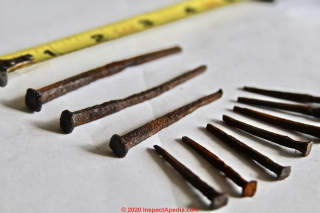 William
William
Thanks for the photo and question: cut nails in an 1810 English style barn
- located where? In the UK? U.S.?
The nails have a uniformly-tapered shank and what looks like a machine-made head that is uniform around the nail shank - making them look fairly-modern to me. Is it possible that they were added later?
- Where were the nails - holding what to what? - any photos of the nails in-situ?
I think these are "modern" cut nails - post 1830 and possibly newer.
Take a close look for splits along the nail length giving the direction of grain of the iron,
and take a look at any remnants of burrs along the nail shanks showing the direction of cutting.
More clues are at NAIL AGE DETERMINATION KEY
On 2020-07-03 by WILLIAM CALVERT
I have extracted these machine cut nails [photo above] from an historic English style barn dated on plaque to have been built in 1810.
I am trying to verify this date as I understand machine cut nails were a brand new idea in 1810. I have found no blacksmith nails in the structure although the timber framing is held together with tree nails - wooden pegs.
I would appreciate any help in aging these nails. Thanks much.
On 2020-06-14 - by (mod) -
Bob
Thank you so much for the nice note; we work hard on this material so I'm really grateful when readers find it useful.
On 2020-06-12 by Bob Dees
Thank you very much for your time, effort and great research, and attention to detail !
On 2020-06-13 - by (mod) - possible Connecticut Shipwreck nail
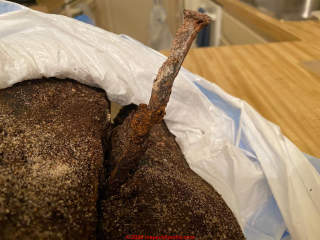 Ryan
Ryan
Well that's certainly a cut nail but it's tough to see details.
I note a tapering under the head but can't tell if that widening along the shank is how the nail was made (an older one) or if it's simply accumulated exfoliated iron.
Those details are in the article NAIL AGE DETERMINATION KEY
See if you can see any splits long the length of the shank - that gives a detail about the iron "fibre" direction that in turn can date the nail.
On 2020-06-10 by Ryan B
Based on other findings in the immediate area, we believe we have discovered a shipwreck on a local Connecticut beach. [Photo above]
We were hoping to receive some help based on the nails we have uncovered - some still stuck in the deteriorated wood we dug up.
There were numerous wrecks along this beach during the 1800’s - being able to identify and date the nails might help us determine which one!
Thank you for any input or information.
On 2019-06-01 by (mod) -
Quite so, though I don't see obvious hand-hewn marks there are a few very faint ones. Also on some boats or ships the level of carpentry was more-skilled than and finished wood surfaces smoother than timbers used in barn and building construction.
On 2019-06-01 by Anonymous
The plank is 8' x 6" x 3", roughly hewn. It could have lost it's edges over years under or on the water. The spike weights 126 grams. My feeling is that it was submerged in the ocean for a long time but broke free and floated up.
Generally timber that has been floating on the water for a long time has been eaten by ship worms and is full of holes. This doesn't have much ship worm activity. This could be that it's a type of wood they don't like.
Photos lost by older Comments Box code - now changed. Please re-post images if you can.
On 2019-05-31 by (mod) -
It will be interesting to see photos of the Timber itself. Often tool marks can give us some indication of the timber age.
On 2019-05-30 by JamesMcKenna
Thanks mod, It was indeed in a large beam of timber that was floating off the shore.
I pulled it out by hand so loose it was. It's 7.5 inches in length with those ripples running the entire length. I pulled the timber ashore and stashed it above the high water mark so I can go back and take a picture of it although it is in a remote part of the shoreline that is hard to access. Will come back with more later. Thanks for your reply
On 2019-05-30 by (mod) -
James,
Thank you for a very interesting nail photo. It's possible that it did cross the Atlantic of course not by swimming or floating but buoyed by wood.
What's interesting and unusual are those regularly spaced ribs which may have been made deliberately to avoid withdrawal that is to create withdrawal resistance. That might help us or other readers make a suggestion of what the nail was for. Straighten. It looks as if it would be more than 6 in long it's a pretty big spike. Probably securing or nailed into a Timber.
On 2019-05-30 by JamesMcKenna
I found this in a piece of timber that floated ashore on the south west tip of Ireland. Because of the Gulf Stream it is possible it crossed the Atlantic
Photos lost by older Comments Box code - now changed. Please re-post images if you can.
On 2019-05-19 by (mod) -
Mark,
It's possible: some wooden ships used massive beams - as much as 16" square.
If your left-hand nail in the photo - the one against the plain side of the ruler - is round as it looks to me, that's a more-modern spike.
On 2019-05-19 by Mark
I found these 5 1/“ hex-head nails near the coast of central California. For ships?
On 2019-05-17 by lornajbernard
thanks for your reply. We've found nails of every size around here, but this was a first. I look forward to seeing what you come up with.
On 2019-05-16 by (mod) -
Lorna
Thank you for the very interesting nail-in-nail example and photo - honestly it's not something I've seen before. It looks as if the smaller nail was being used to affix a hanger-spike to a timber or beam. Or possibly this was a hand-forged spike whose original fabrication attempted to build up the iron spike by combining older materials into one.
I'm doing some research and will post further findings here.
On 2019-05-15 by Lorna Bernard
I came across this "nail within a nail" on our property, which was the site of a butcher shop and a dry goods store dating back to the 1880s. (We live in a historic California Gold Rush town.) Do you know what it's called, and what it was used for? Thanks in advance.
Photos lost by older Comments Box code - now changed. Please re-post images if you can.
On 2020-12-13 - by (mod) -
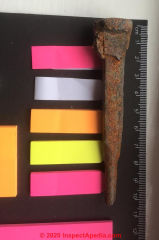 This NAIL AGE IDENTIFICATION KEY
This NAIL AGE IDENTIFICATION KEY
https://inspectapedia.com/interiors/Determine-age-of-old-nails.php
May be of help to you
On 2020-12-13 by Paul Acheson
Hi Dan,
As an expert in old nails could you advise what sort of nail I have found and is it from a ship?
Many Thanks
Paul
Hi All
I found this nail / spike on a beech in Weymouth Bay, Dorset UK. I think it must be from ship wreck, there are many wrecks recorded in the area. Does anyone know how old this one is? It feels like wrought iron or cast iron and is 100mm / 4 inches long, square shank and rounded at the end, see photos.
Any comment welcome
Best Regards
Paul
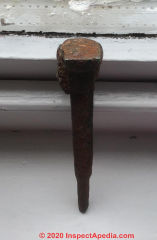
On 2020-10-07 - by (mod) -
Stephen
I will delete some of your duplicate photo postings.
Note to readers posting comments: if your comment contains an image, web link, or text that looks to the software as if it might be a web link, your posting will appear after it has been approved by a moderator. Apologies for the delay.
On 2020-10-07 by (mod) - fluted shaft hardened concrete nails
Stephen
Those parallel grooves also referred to as a "fluted shaft nail" on the nail shank look like a modern hardened masonry nail.
These nails, typically hammer-driven into concrete, are also sold in a magnetized version used by surveyors, such as the ChrisNik Magnails shown below.
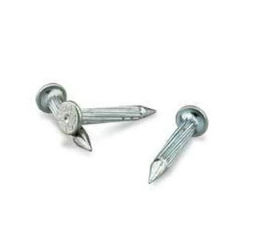
On 2020-10-07 by Stephen
On 2020-10-07 by Stephen
How do we get it to upload an image? Everything appears to work with the add image feature, except it doesn't actually upload it.
On 2020-08-31 by (mod) - Puget Sound WA Nail Features
Shelly
Thank you for the interesting photos and question. I can't make out much detail but your nail on the right of your ruler is a cut-nail, giving a rather broad date range as you'll see in the home page at the recommended articles (end of this page) for this topic.
On 2020-08-24 by Shelly
Found these two nails next to a old warn down pillars posts and a huge rock carving. No know docks where here in this area. Could this be a old shipping area or boat nail, Indian markers on the shore maybe. Would like ant help. This is in Puget Sound WA.

On 2020-11-02 - by (mod) -
 Vladimir
- regarding your old nail photo (shown above)
Vladimir
- regarding your old nail photo (shown above)
Let's try the Nail age determination key at
https://inspectapedia.com/interiors/Determine-age-of-old-nails.php
On 2020-11-02 by Vladimir
Found this nail in Daytona Beach, trying to find out how old this nail might be.
On 2020-10-22 - by (mod) -
NAIL AGE DETERMINATION KEY https://inspectapedia.com/interiors/Determine-age-of-old-nails.php
may be of some help, Louise
On 2020-10-22 by Louise Black
Found this while magnet fishing along the kennet and Avon canal UK. Would be very interested to know more about it
On 2020-10-12 - by (mod) -
I agree; though there is a very long history of machine-cut carpet and other small tacks, your tacks are probably carpet tacks, or possibly upholstery tacks that look rather modern.
On 2020-10-12 by Sophia Kelly Shultz
My husband and I agree that the tacks are after-market, possibly used if the felt was replaced at some point.
This would account for the glue which held the tacks in place. My feeling is that the person who owned the desk was unhappy with their repair, and nailed the felt down so that it wouldn't distort when the desk was closed.
We are in the US, Pottsville, PA. I found it at the Salvation Army in Pottsville. I work as a volunteer: we do receive a fair number of antiques and I spotted it before it made it out of the back room. Our house and the house next door are dated 1864. Pottsville itself was incorporated as a borough in 1828, and there are buildings from that era still extant.
The town's location on the Schuylkill River and in close proximity to the Reading and Pennsylvania Railroads makes it quite possible that the desk was brought from elsewhere, perhaps from Philadelphia.
On 2020-10-11 by (mod) - age of tacks & hardware in Wilburmilk lap desk
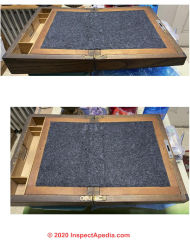 Those are particularly nice brass hinges - making me guess the hardware and perhaps the folding lap desk are from the 1850s but those tacks are curious. Tacks were one of the earliest machine-made metal fasteners, as you'll see in the history given in this article series. Blanchard's machine dates from around 1806.
Those are particularly nice brass hinges - making me guess the hardware and perhaps the folding lap desk are from the 1850s but those tacks are curious. Tacks were one of the earliest machine-made metal fasteners, as you'll see in the history given in this article series. Blanchard's machine dates from around 1806.
See if you can identify other instances of the hinges or of the lock mechanism.
Knowing the context is often a basic starting point for guessing the age of building components, furniture, hardware, lap desks.
Country
City
where found
age of buildings in the area
history of acquisition
etc.
On 2020-10-11 by Sophia Kelly Shultz
The desk can't be closed right now because the glue is still drying. The outside is very plain; we think it is walnut. The inside is pine. There's a stamp on the back that reads something like "Wilburmilk" (no joy on Google). It's a rubber stamp. The glue fluoresces green, and when wiped down with a damp cloth smelled like resin.
On 2020-10-11 - by (mod) -
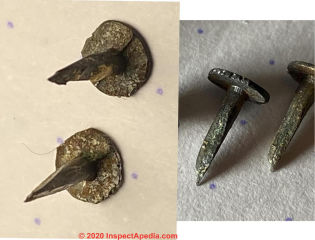 Those are nice photos of modern machine made tacks, Sophia. Can you also post an image of the lap desk?
Those are nice photos of modern machine made tacks, Sophia. Can you also post an image of the lap desk?
On 2020-10-11 by Sophia Kelly Shultz
This is a GREAT resource!
I found a slope lap desk at our Salvation Army and fell in love with it. Its felt writing surface was totally rotted, so I'm preparing to clean it off so that I can actually use the desk.
About a zillion nails were used to secure the felt at the hinges; getting them out was a chore because they were also glued in place, my guess is with resin. This made examining the nail holes extremely difficult.
Some of your pictures are very similar to these finishing nails, but I wanted to show them to you. If you have any input, I'll be grateful for it!
On 2020-10-10 - by (mod) -
Amy:
Often there are many additional house age one can find, even in a renovated home, by careful inspection; layout, architecture, site debris, and the several topics suggested in the ARTICLE INDEX such as saw marks on original framing lumber that you may see in the attic, basement or crawl space.
On 2020-10-10 by Amy
I'll have to investigate further! Most of the house has been renovated extensively so the attic and anything we can figure out inside of it is our only hope! Thank you!
On 2020-10-09 - by (mod) -
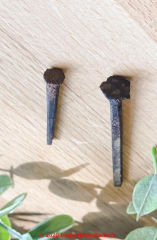 Yes that larger-headed nail looks hand-wrought. The two nails look of different age to me.
Yes that larger-headed nail looks hand-wrought. The two nails look of different age to me.
Remember to note just where and how the nail was used; for example if we see what appear to be original nails in original framing of a building we can figure they're probably as old as the structure while if we're seeing add-on structure or materials obviously we can't assume that.
Take a look at the other building age clues in this article series - when deciding the age of a building it is important to use all of the available evidence and to correlate it; saw kerfs or marks, hammer marks, timber surfaces, other building hardware, architectural style : there is plenty to consider.
Rebuilding an 1850s home in Wappingers Falls NY I was thrilled to find, on tearing up a damaged floor below a toilet, old newspapers that pretty much told me the date at which plumbing - at least the toilet - had been added to the home. The plumber stuffed newspapers all around the toilet bend - maybe hoping that if his work leaked it would not be discovered until after he'd safely escaped.
On 2020-10-09 by Amy
Thank you for the resources! I guess I just thought this would help to figure out what time frames we were looking at for construction here. From what I can tell, the nail head and from the nail head to the shank is irregular, but the shank towards the very bottom is more uniform. Here's another picture of it and another one that we found up there as well.
On 2020-08-31 - by (mod) -
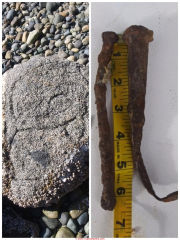 Shelly
Shelly
Thank you for the interesting photos and question.
I can't make out much detail but your nail on the right of your ruler is a cut-nail, giving a rather broad date range as you'll see in the home page for this topic.
On 2020-08-24 by Shelly
Found these two nails [shown above] next to a old warn down pillars posts and a huge rock carving.
No known docks where here in this area. Could this be a old shipping area or boat nail, Indian markers on the shore maybe. Would like ant help. This is in Puget Sound WA.
On 2020-08-23 by Allie
Thanks! It’s 6 inches and two inches wide. The thickest part of the wedge in the first picture is 1 inch.
Picture of one side. It looks like it’s staring to corrode after we removed some of the crust.
On 2020-08-23 - by (mod) - hand forged wedge from Lake Ontario?
This may be a wedge, hand forged, used in log splitting.
Very interesting; can you give dimensions?
Thank you.
On 2020-08-23 by Allie
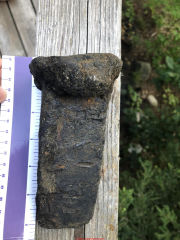 Found in the water in a lake in Ontario, Canada - very heavy. Can chip off the crust. Haven’t finished....
Found in the water in a lake in Ontario, Canada - very heavy. Can chip off the crust. Haven’t finished....
One side has some tool marks running perpendicular. Weight 3-5 pounds. The head is irregular and the whole thing is on a slant.
Is this a nail? Or a wedge or spike? Having a hard time finding out what it is...
Hello! I found this in the water (about a foot under the sand). We chipped away at it a bit and the crust around it came away. It smells a bit like rotten eggs. I’m having trouble figuring out if it’s a nail or a spike or a wedge.
It’s very heavy (about 3-5 pounds.) Any help would be appreciated.
On 2020-08-15 - by (mod) -
Jesse
Try posting a photo using the add image button
On 2020-08-15 by Jesse Ward
Hey guys, I've found this huge spike in a river this week. I cleaned it up a little bit, but it looks really old, and I can't for the life of me imagine what this was used for, except as a sword! It's close to 3 feet long!
On 2020-08-14 - by (mod) -
Beautiful, looks like brass, spike, cut perhaps with hand forged head. Check the details such as burrs along the side of the spike - as per
NAIL AGE DETERMINATION KEY
On 2020-08-13 by Nate
Found this in a piece of waterlogged wood down at Westmoreland State Park on the Potomac in VA. The piece of wood also had what looked to be a wooden peg in it, I tried but couldn't pull that out. I was able to remove this brass spike though.
From what I can tell online it seems to be from a sea-going ship from 150-200 years ago. Curious if anyone has any other information that might help date or shed light on where this might have come from. Thanks!
On 2020-08-06 by bela Lajos - antique nails from Budapest, castle district
Found these in the old castle district in Budapest, which has been the site of countless battles ranging from early Roman times to the late 1800s.
What kind of nails have this strange shape, if they are nails at all?
I have been finding these in the Budapest caste district while metal detecting.
The castle has existed since early Roman times and has been the site of countless battles from that time all the way to the late 1800s. What I am wondering is what kind of nails are these, if they are nails at all?
I have never seen such nails that look like arrowheads, but have been told to ask here.
On 2020-07-28 by shy
I found this copper nail amalgamated with a variety of other metals in a tiny divot it in sandstone by the ocean at Little Bay Sydney. 75mm long, 20mm diameter at near the larger head
Question: are these nails and bolts from a ship?
Hello, Can you please tell me how old this hardware is and If it would of been used to make a ship or not? I found them in water so they are weathered. I’d really appreciate it!
Thank You!!
David
Reply: nails, bolts, rivets used in shipbuilding date back over 2,400 years
Hi David
You have an assortment of bent and straight iron hardware there; a cut nail or two, a nut and bolt assembly, and a large machine made bent spike.
The lines of the spike are least rusted and thus it's easiest to examine for hand-tooling marks (none found); I think this is mostly modern hardware, the spike perhaps from post and beam or dock construction.
NAIL AGE DETERMINATION KEY can help you make an informed guess about the the age of these fasteners.
Were these fasteners used to make a ship? Early wooden ships used large wooden spikes to secure mortise and tenon joints - "Treenails"; as water, especially salt water is corrosive, metal nails of later ships and boats were galvanized or bronze.
Unless we have more context I can't make a useful guess at that answer; a wide variety of fasteners, including spikes, smaller nails, rivets, and screws were all used in shipbuilding.
More modern nails used in wooden boats are copper or bronze, typically ring-shanked with wide heads. Cut nails produced as rosehead square shank spikes of lengths from 50 to 200 mm long are still produced.
Metal nails used in ships have an ancient history as cited in this example research
- Shalev, S., Y. Kahanov, and C. Doherty, NAILS FROM A 2,400 YEAR OLD SHIPWRECK: A STUDY OF COPPER IN A MARINE ARCHAEOLOGICAL ENVIRONMENT [PDF] JOM Journal of the Minerals, Metals and Materials Society 51, no. 2 (1999): 14-17.
Abstract: The metal nails that fastened the wooden components of a 2,400 year old ship found along the coast of Kibbutz Ma'agan Mikhael, Israel, were made of unalloyed copper that was intensively hammered. A lead isotype analysis of one nail indicates with high probability that it was made of copper from Cyprus.
The copper of the nails in the wood was replaced entirely by copper sulfide mineral, displaying the occurrence of deep anaerobic conditions in a breaker zone under a shallow cover of sand. the slow decay of the cellulose and hemicellulose in the wood is a possible explanation for the specific necessary environmental conditions. - Tripati, Sila, M. Sujatha, R. Vijendra Rao, and K. Satyanarayana Rao. "Use of timber in shipbuilding industry: Identification and analysis of timber from shipwrecks off Goa coast, India." Current Science (2005): 1022-1027.
Below: modern bronze boat nails.
And the following illustration of modern Rosehead Square-Shank Spikes used in boatbuilding are from the Glasgow Steel Nail Co.
- Source: Glasgow Steel Nail Co. (Division of Acorn Mfg.), 457 School Street Mansfield Massachusetts 02048 USA Website: http://www.glasgowsteelnail.com, retrieved 20198/10/12 original source: http://www.glasgowsteelnail.com/Boats.htm
These spikes are sold in sizes from 50x4mm to 200 x 8mm and are used world-wide, typically for historic restoration work.
Question: Hook top nail head: wire fencing nail from North Carolina
2019/09/15 Barry asked
Dear sirs..
I found this spike in the parking lot where I work in the southwestern tip of N.C.
Any idea of age and what kind of a fastener it was ?
Hi .... I have another pic of the old spike I found which has I think the #1 stamped on it
Reply: Antique wire fencing nails
I noted by email that may be a wire fencing nail.
In the U.S. there was an explosion of nail inventions in the last half of the 1800s including a range of nails used in fencing, some with special heads to hold wire against the wood post and some including a protrusion that made removal of the nail with a hammer easier should fencing repair or adjustment be needed.
This is the Brinkerhoff wire fence nail discussed in the article NAIL AGE DETERINATION KEY (live link at end of this page)
Question:
20190/9/12 Wazoo Gotya asked:
Found this in pensacola florida can anyone give me any detail on maybe how old it is
Reply:
From the head shape and rust patterns, Gotya, I'm guessing this is a modern cut nail - 20th century or late 19th century.
We discuss these wire fencing nails at NAILS, AGE & HISTORY

On 2019-05-01 by (mod) - History & age of nails "Wales-Spike-385-CR.jpg">Thanks CR this looks like the rusted-off head of a large spike - such as I'd expect to see in post and beam construction or at the seaside, dock construction.
Knowing what was around where you found the nail, old buildings, seaside, history occupancy, etc. would also be helpful.
I suspect from the rust patterns that the "grains" in the iron run parallel to the shaft direction, making this one of the more-modern alloys - perhaps after 1830. (I need more research on nail fabrication in Wales and the rest of the UK).
Nail fabrication in the UK dates from Roman times but machine made nails are of course modern.
In general in the UK cut nails or machine fabricated nails are not likely to be dated earlier than 1811 - the earliest report I have found was of Joseph Dyer, established cut nail fabrication in Birmingham ca 1811.
I've added some UK citations in the history of nail fabrication references in the article NAIL AGE DETERINATION KEY (live link at end of this page) (you may need to refresh your browser cache to see them).
Pay particular attention to the PDF file about the Ewbank Nail listed under Australia nail history as this nail was also used throughout Britain.
Therein see the square-point nail from 1893.
On 2019-05-01 by CR
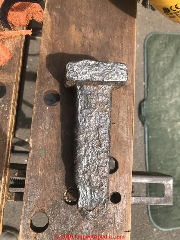 Ahh yeah dimensions would be useful. Another photo included. After some more clean up I’ve found some more details.
Ahh yeah dimensions would be useful. Another photo included. After some more clean up I’ve found some more details.
There is a clear seam on top of the head where the shaft was attached to the head like a collar. The metal also shows some interesting patterns not sure if this is from weathering or the type of metal/manufacturing. I would like to believe this is a nail but seems unlikely that this can really be classified as such.
On 2019-05-01 by (mod) -
Nice job and photo; your cleanup of the metal spike? shows a very square head and straight line sides suggesting this is a machine made nail or spike; next time include a ruler in the photo so we have an idea of its dimensions.
On 2019-05-01 by CR
I gave it a quick clean up, removed most of the rust.
So here is another photo. I’ve never seen something like this before and haven’t been able to find any similar examples online. I’m not even 100% sure it is a nail but that’s my best guess.
On 2019-05-01 by (mod) -
Thanks for the interesting photo. I can't quite see enough nor do we know enough to have much of an opinion about the age of this particular Fastener. Please take a look at the nail age determination questions that we suggest at
And let me know what those tell us
On 2019-04-30 by CR
Hello,
I was hoping you could shed some light on something I found recently, image attached. I found this while out walking the dogs in sunny Wales.
On 2019-04-19 by (mod) - machine made tack
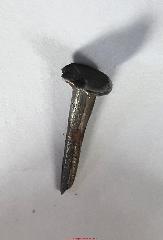 Kathy
Kathy
While this could be an early machine-made tack it's definitely modern - machine made, not hand forged. Notice the smooth flat head, absence of hammer marks, uniformly tapered edge, and that center ridge that may be from a cutting machine. Those details place the nail in the outline of dates on the page NAIL AGE DETERINATION KEY (live link at end of this page)
No earlier than 1848 - assuming your picture frame and nails were made in North America - and possibly as late as yesterday.
On 2019-04-1 by kathyfox1953
I recently came into possession of an old picture frame. The frame has two old nails holding the hanging wire on. Can you please tell me when this nail was made and how it was made? The nail is 1/2 inches long. Thank you so much.
On 2019-04-19 by (mod) -
Roger:
Use the Add Image button to show us a photo of the chair and in a second comment perhaps you could post a photo of the nails you want to replicate.
I suspect Tremont can get you pretty close without making new nails from scratch.
Tremont Nail Company, P.O. Box 31, Mansfield, MA 02048, Tel: 800-835-0121, 508-339-4500 Website: http://www.tremontnail.com/
On 2019-04-18 by roger francis
I have an antique, very old hooped spindle back windsor chair which use oblong shaped nails, not square headed. I am trying to date the chair. The nails looked to be forged.
On 2019-03-28 by (mod) - round nail shaft diameter and symmetrical cut-point
Stew
The you perfectly round shaft and regular cut points suggest me but it's not a very antique spike but it is an interesting one. It's quite clear from the weld marks on the shaft that it was welded to some other structure and of course as you've doubtless noticed, the head has been smashed as well.
On 2019-03-28 by stew
Bak in the early 1970s while exploring the coastal caves out near the entrance to the San Francisco Bay with friends when I was a kid, I spotted this spike wedged down in the rocks at low tide. Stupidly (kids are fearless-- no judgement)
I climbed down to get it. I've had it ever since and never really knew where it may have come from or when it was made.
It measures approx 13.5 inches with a 1 inch diameter shaft and a 2 inch diameter head. Any ideas?
On 2019-03-28 by (mod) - irregular nail shaft diameter and rectangular edges vs round nail shaft
Tracy
The irregular nail shaft diameter and remains of somewhat rectangular edges make this look like an antique cut nail or possibly a hand wrought nail. But I'm not sure from your photo.
If the nail is essentially round in cross section it's a modern wire-drawn nail.
On 2019-03-18 by Tracy
I found this nail in a load of gravel in Missouri. It looks to me like its a hand wrought nail, but I really have no idea. Any thoughts?
On 2018-12-27 by (mod) - ding or hammer marks on old round nails may mean salvage & re-use
RE: Cat's round nail age:
if there were hammer marks on a round nail: such ding marks on a round nail could be from straightening a bent spike for re-use.
These were valuable back when - depending on the location, even in the 1930s and 1940s in some areas of the U.S. younger family members were put to work salvaging nails and spikes from old wood and straightening them to pass them on to their carpenter dad or uncle. (cf. P Galow, PA)
Your nail looks more as if many indentations are pitting from corrosion.
On 2018-12-10 by Cat - nail with many ping marks on the sides
The head is gone. It has many ping Mark's on the sides. It looks hand made. My camera is not so great.
Thank you for your reply!
On 2018-12-09 by (mod) - machine made wire nail - round nail found in a Bayou
I can't see the head in the photo but it looks as if you're handling around, machine-made Spike of considerable size.
If found in a bayou I would expect such a spike was probably used in the construction of a dock.
On 2018-12-08 by Cat
Found this in a bayou. Cleaned it off a bit. Is it a nail? What was it used for?
Thank you!
On 2018-11-18 by Rich
I found this nail has a triangle head. Looks like the nail may have a twist
On 2018-05-10 by (mod) -
I don't think manufacturing inconsistency is going to give us a date for when the nails were made. I see that sort of inconsistency even now depending on the fabricator.
On 2018-05-09 2 by karl
hi. i'm trying to get a guesstimate on age of wire nails with inconsistent heads. slightly different sizes and some a bit offset to center.
i've searched and searched but can't find information about when wire nails became consistent with head sizes and when things were still rough... any help would be appreciated. thanks! (no image due to broken phone)
On 2018-02-06 by (mod) - old nails in 100+ year old log timber structure in Ca
Anon
you are welcome to use the picture frame icon to the right of the comment button to attach some sharp photos of those Nails as that would certainly be of interest to other readers
On 2018-02-04 by Anonymous
Found really cool old nails in 100+ year old log timber structure in ca well preserved looks like Natchez antibellum
On 2018-02-04 by William pulliam
What kind of nail is this
On 2017-08-30 by MWoo - old looking nails on the bank of the Themes river in London
Hey there, I found two really old looking nails on the bank of the Themes river in London, and I'm very curious as how to go about applying a rough date to them.
Anyone have any advice?
Thanks!
On 2017-05-15 by (mod) -
Beyond that, in my opinion more significant to look at the types of saw kerf marks or tool marks on beams as part of guessing their age.
On 2017-05-15 by (mod) - nails in chestnut beams
Anon,
Regarding Chestnut beams, you haven't asked a question but I'm guessing you're asking the relationship between the presence of chestnut beings in buildings and building age.
If we exclude recycled use of old beams in newer buildings, in the United States the chestnut blight had taken a major toll on chestnut trees by 1940.
So it's safe to figure that by the nineteen-fifties those beams would have been rare in most buildings.
On 2017-05-15 by (mod) -
We have some comments about the relationship between type of nails and building age
in NAILS, AGE & HISTORY and also in the comments below for this article.
Please take a look and let me know what you think. Because nail making machine reappeared in different parts of various countries and different times there's no single correct answer to the significance of a machine cut nail without considering the geographic location.
On 2017-05-14 by Anonymous
Chestnut beams
On 2017-05-14 by Anonymous
How to tell age by nails
On 2017-05-10 by (mod) -
Dave, I took a look at your excellent photo and later if it's ok with you I will post it
However I could not see for sure that the head of the nail was hand-forged. You might take a close look for Hammer marks. It's also the case that the age of a nail depends in part on where in the world or country it was first used.
That's because in the US for example machines that made cut nails appeared earlier on the East Coast then in the middle of the country or farther west. If the head and body of the nail are hand rough, most likely it was made before 1800 if your property is on the east coast of the US
On 2017-05-10 by Dave Worst
Can you tell the age of this nail 5 1\2" long
Square the bottom half. Wor320@aol.com
Sorry not letting me paste pic
On 2014-08-11 by (mod) - spike in our LI, NY backyard
Greg
Use our email found at our CONTACT link to send me some sharp photos if you can.
On 2014-08-10 by Greg Bruschi
Found what appears to be a very spike in our LI, NY backyard. It looks like some of the ship building
...
Continue reading at NAILS, AGE & HISTORY - topic home, or select a topic from the closely-related articles below, or see the complete ARTICLE INDEX.
Or see AGE OF NAILS - FAQs-2 for more questions & answers about determining the age of nails.
Or see these
Recommended Articles
- AGE of a BUILDING, HOW to DETERMINE - home
- DOOR HARDWARE AGE
- NAILS, AGE & HISTORY - home
- HORSESHOE & HORSESHOE NAIL AGE
- NAIL & HARDWARE, AGE RESEARCH
- NAIL & HARDWARE CLEAN-UP
- NAIL AGE DETERMINATION KEY - use this key to guess at the age of your nail or spike
- NAIL ID & AGE: CUT NAILS
- NAIL ID & AGE: HAND FORGED NAILS
- NAILS in BARTER & TRADE
- NAIL SPLITS & CRACKS vs AGE
- NAIL TYPE, ANTIQUE, IDENTIFICATION KEY
- RAILROAD SPIKES
- RAILROAD SPIKE AGE - CONTEXTUAL CLUES
- SAW & AXE CUTS, TOOL MARKS, AGE
- WINDOW HARDWARE AGE
Suggested citation for this web page
NAILS & HARDWARE, AGE FAQs at InspectApedia.com - online encyclopedia of building & environmental inspection, testing, diagnosis, repair, & problem prevention advice.
Or see this
INDEX to RELATED ARTICLES: ARTICLE INDEX to BUILDING AGE
Or use the SEARCH BOX found below to Ask a Question or Search InspectApedia
Ask a Question or Search InspectApedia
Try the search box just below, or if you prefer, post a question or comment in the Comments box below and we will respond promptly.
Search the InspectApedia website
Note: appearance of your Comment below may be delayed: if your comment contains an image, photograph, web link, or text that looks to the software as if it might be a web link, your posting will appear after it has been approved by a moderator. Apologies for the delay.
Only one image can be added per comment but you can post as many comments, and therefore images, as you like.
You will not receive a notification when a response to your question has been posted.
Please bookmark this page to make it easy for you to check back for our response.
Our Comment Box is provided by Countable Web Productions countable.ca
Citations & References
In addition to any citations in the article above, a full list is available on request.
- In addition to citations & references found in this article, see the research citations given at the end of the related articles found at our suggested
CONTINUE READING or RECOMMENDED ARTICLES.
- Carson, Dunlop & Associates Ltd., 120 Carlton Street Suite 407, Toronto ON M5A 4K2. Tel: (416) 964-9415 1-800-268-7070 Email: info@carsondunlop.com. Alan Carson is a past president of ASHI, the American Society of Home Inspectors.
Thanks to Alan Carson and Bob Dunlop, for permission for InspectAPedia to use text excerpts from The HOME REFERENCE BOOK - the Encyclopedia of Homes and to use illustrations from The ILLUSTRATED HOME .
Carson Dunlop Associates provides extensive home inspection education and report writing material. In gratitude we provide links to tsome Carson Dunlop Associates products and services.


